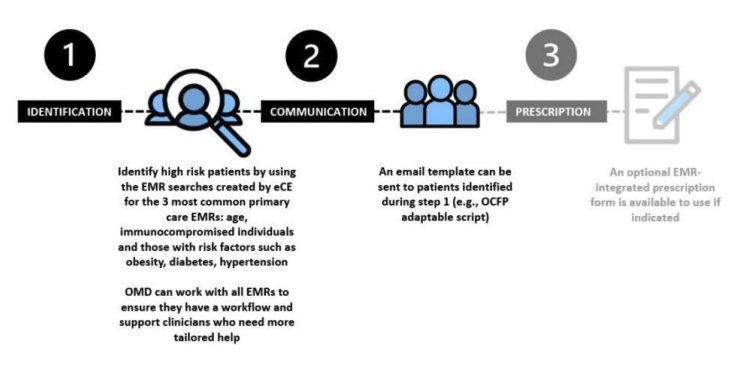News & Updates
Memo: Paxlovid prescribing in primary care: Testing and tools
To:
Primary care providers
From:
Dr. Sacha Bhatia, Population Health and Value-Based Health Systems Executive
Dr. David Kaplan, Vice-President, Quality
Primary care providers continue to be at the forefront of COVID-19 therapeutics access for Ontarians through substantial effort and leadership. Thank you for your contributions to ensuring high-risk individuals receive the right treatment. Please see below for information about Paxlovid testing pathways and prescribing tools for primary care providers.
Paxlovid Testing Pathways
Recent evidence suggests that rapid antigen tests (RATs) are less sensitive to the dominant Omicron variant and sub-variants than previous strains. Samples collected nasally to use with an RAT often yield a negative result early in the course of infection, particularly before day three.1 Estimates assume that approximately 40% of cases with a positive polymerase chain reaction (PCR) result are not detected by RATs up to day seven of infection. The risk of false-negative RATs are not eliminated by repeat testing. 2 However, RATs can more reliably detect infectious cases of the Omicron variant in combined oral-nasal samples. 3 Primary care providers may refer patients to Rapid Antigen Testing: How to Collect a Sample (available in 26 languages) for instructions on how to use the combined oral and nasal method to collect a sample.
The lower sensitivity of RATs may have significant Paxlovid access implications given that prescribing in Ontario requires a positive COVID-19 result via RAT or PCR test. If high-risk patients who would be eligible for Paxlovid are experiencing symptoms but are testing negative by RAT, a PCR test is recommended whenever possible to meet the five-day treatment window. Eligibility for PCR testing in Ontario includes outpatients being considered for COVID-19 treatment. For more information, consult the Ontario COVID-19 Science Advisory Table’s brief on the use of RATs during the Omicron wave.
Paxlovid Prescribing Tools
In April, Ontario Health collaborated with partners such as OntarioMD, the eHealth Centre of Excellence (eCE) and the Ontario College of Family Physicians to develop and mobilize additional Paxlovid tools in response to prescribing barriers raised by the primary care community. The following is a review of existing tools that may be helpful.
- EMR searches to support the identification of patients who are high risk
- An adaptable script to communicate with high-risk patients
- Optional EMR-integrated Paxlovid prescription forms
This graphic and subsequent text outline these tools and suggested process for their use.

- EMR Searches for Eligible Patients
Identify high-risk patients based on age, immunocompromised individuals, and those with risk factors such as obesity, diabetes, or hypertension using EMR searches created for the three most common primary care EMRs (Accuro, Oscar and PS Suite).
The eCE has created searches that use EMR data to identify patients who meet eligibility criteria for Paxlovid (available on their website, including implementation supports). A guide to indication/prescription is available on the OntarioMD website.
If individuals identified via these searches do not have a recent serum creatinine, providers may consider ordering this for the highest-risk patients while they are well.
- Adaptable Script for Patient Communication
Send an email to patients identified during step 1 (e.g., using the Ontario College of Family Physicians’ adaptable script).
The Ontario College of Family Physicians developed an adaptable script that can be sent to patients identified as high risk through the EMR search. This script provides comprehensive information about Paxlovid for patients such as answers to common questions, when to call the doctor’s office, the eligibility self-screening tool and where to find clinical assessment centres and dispensing pharmacies (note: supply at individual sites may vary).
- Paxlovid Prescription Form Use an optional EMR-integrated prescription form when Paxlovid prescription is indicated. A single-page Paxlovid Prescription Form was developed by Ontario Health Regions. It includes the eligibility criteria for Paxlovid and can be found here for various EMRs. A common COVID-19 therapy referral form can be found here. Integration with other EMRs can be supported by OntarioMD. This form is intended as an aid and is not required. eCE has also developed a post-COVID-19 EMR tool.
Additional resources for Paxlovid prescribing can be found on the Centre for Effective Practice’s website.
Thank you again for your significant contributions to the health of Ontarians. We look forward to continued collaboration in ensuring primary care teams are supported to prescribe COVID-19 treatment for those who need it most.
1. Adamson B et al, 2022. medRxiv; 2022:2022.01.04.22268770. https://doi. org/10.1101/2022.01.04.22268770
2. Soni A et al 2022. Available from: https://dx.doi.org/10.1101/2022.02.27.22271090
3. Jüni P et al, 2022. Use of Rapid Antigen Tests during the Omicron Wave. Available from: https://covid19-sciencetable.ca/sciencebrief/use-of-rapid-antigen-tests-during-the-omicron-wave/
Connect with Other Primary Care Providers and Resources in Northern Ontario
Primary care MD’s and NP’s face common challenges practicing in Northern Ontario and we know we will be more successful when we can face them together!
